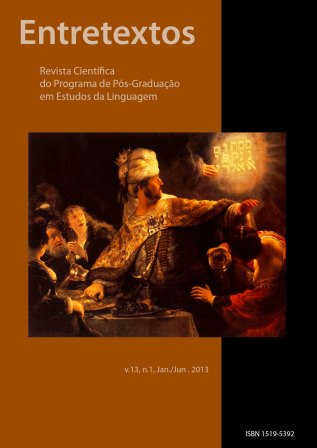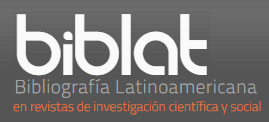Constructions of metathesis in Peruvian youth slang: an optimalistic analysis
DOI:
https://doi.org/10.5433/1519-5392.2013v13n1p420Keywords:
Spanish Language, Slang, Optimality Theory, MetathesisAbstract
This article aims to demonstrate how the phenomenon of metathesis operates on lexical items from the Peruvian youth slang (called jeringa), using for it the theorical tools of Optimality Theory (GONÇALVES et al., 2009; CAGLIARI, 2002; COSTA, 2001). More specifically, we'll demonstrate that certain linguistic forms emerge in the speech of its users over others seemingly possible. Metathesis is a formal process which consists in reordering of syllables or segments of a specific word (CRYSTAL, 1988) whose purpose may be obscure its real meaning (cryptic function), print on it new connotations (identity function) or simply "play" with the caller (playful function) (CALVET, 1994). As an example, we observe the use of the forms "cofla" and "dorima" instead of flaco (boy) and marido (husband), respectively. For this research we analyzed, based on restrictions hierarchically listed, two-syllable words extracted from the gossip column Ya fuiste, which is daily published in the Ajá tabloid, a widespread newspaper of high popular character in the Peruvian capital. Regarding the results of this research, we have found that the shapes analyzed obey both restrictions of the Spanish language as the phenomenon itself, being composed of only one syllable foot and have a limit regarding the reordering of its segments or syllables, since drastic rearrangements that would make the word unrecognizable to the speaker/listener, hampering their identification and, consequently, their acceptance by the same (HUME, 2001).Downloads
References
BALBÍ, Carmen Rosa. ¿Una ciudadanía desconyuntada o redefinida por la crisis? De 'Lima la horrible' a la identidad chola. In: BALBÍ, Carmen Rosa; CHÁVEZ, Irma. (orgs.). Lima: aspiraciones, reconocimiento y ciudadanía en los noventa. Lima: Fondo Editorial PUCP, 1997. p. 11-27.
BAT-EL, Outi. Stem Modification and Cluster Transfer in Modern Hebrew. 1992. Dissertação (Mestrado) - Tel-Aviv University, Tel-Aviv.
BAT-EL, Outi. Phonology and Word Structure in Modern Hebrew. 1989. These (Doctorate) - University of California, Los Angeles.
BELCHOR, Ana Paula Victoriano. Construções de truncamento no português do Brasil: análise estrutural à luz da Teoria da Otimalidade. 2009. Dissertação (Mestrado em Letras) - Universidade Federal do Rio de Janeiro, Rio de Janeiro.
BENDEZÚ NEYRA, Guillermo. Argot limeño o jerga criolla del Perú. Lima: Editorial Universo, 1977.
BUTSKHRIKIDZE, Marika; VAN DE WEIJER, Jeroen. On v-metathesis in Modern Georgian. In: HUME, Elisabeth; SMITH, Norval; VAN DE WEIJER, Jeroen (eds.), Surface Syllable Structure and Segment Sequencing. Leiden, NL: HIL Occasional Papers, 2001, p. 91-101.
CABELLO, Ana Rosa Gomes. Linguagens especiais: realidade linguística operante. Revista Uniletras, v. 24, n. 1, p. 167-182, dez. 2002.
CAGLIARI, Luis Carlos. Análise Fonológica: introdução à teoria e à prática, com especial destaque para o modelo fonêmico. Campinas: Mercado das Letras, 2002.
CALVET, Jean-Louis. L'argot. Paris: PUF, 1994 (Que sais-je? n° 700)
CARRIÓN ORDÓÑEZ, Enrique. La jerga de los malhechores peruanos. In: IV CONGRESO INTERNACIONAL DE LA ALFAL, 1975, Lima. Anais… Lima: UNMSM, 1978. p. 268-279.
COSERIU, Eugenio. Lições de Linguística Geral. Rio de Janeiro: Ao Livro Técnico, 1980.
COSTA, João. Gramática, conflitos e violações: introdução à teoria da Optimidade. Lisboa: Editorial Caminho, 2001.
CRYSTAL, David. Dicionário de Linguística e Fonética. Rio de Janeiro: Jorge Zahar, 1988.
DAVIDSON, Joseph Orville Jr. A Contrastive Study of the Grammatical Structures of Aymara and Cuzco Kechua. 1997. These (Doctorate) - University of California, Berkeley.
DOR, Daniel. Deriving the verbal paradigm of Modern Hebrew: A constraintbased approach. 1993. Dissertation (Master) - Stanford University, California.
DRAE: Diccionario de la Lengua Española, 22. ed. (ed. on-line) Disponível em http://www.rae.es/.
DUBOIS, Jean. Dicionário de Linguística. 16.ed. São Paulo: Cultrix, 1994.
FLEMMING, Edward. Laryngeal metathesis and deletion in Cherokee. UCLA Working Papers in Linguistics: Cherokee Papers from UCLA, n. 16, p. 23-44, 1996.
FOLEY, Lawrence. Phonological Variation in Western Cherokee. New York & London: Garland Publishing, 1980.
GÁLVEZ, Judith. Lenguaje jergal. Lima: Hipocampo Editores, 2002.
GÁLVEZ, Judith; MENDOZA, Aída. Latín y jerga: procesos paralelos. Revista Fabla. V. 3, n. 3, p. 129-154, 2005.
GONÇALVES, Carlos Alexandre et al. (Org.). Otimalidade em foco: morfologia e fonologia do português. Rio de Janeiro: Publit, 2009.
GONÇALVES, Carlos Alexandre; ANDRADE, Kátia Emmerick; RONDININI, Roberto Botelho. Glossário comentado de restrições. In: GONÇALVES, Carlos Alexandre et al. (Org.). Otimalidade em foco: morfologia e fonologia do português. Rio de Janeiro: Publit, 2009, p. 229-250.
GONÇALVES, Carlos Alexandre; PIZA, Mônica de Toledo. Pequena introdução à Teoria da Otimalidade. In: GONÇALVES, Carlos Alexandre et al. (Org.). Otimalidade em foco: morfologia e fonologia do português. Rio de Janeiro: Publit, 2009. p. 11-44.
HERZALLAH, Rukayyah. Syncope and epenthesis in Palestinian Arabic: an instance of dericational constraint violation. 1987. Dissertation (Master) - Cornell University, New York.
HEWITT, George. Georgian: a Structural Reference Grammar. Amsterdam/Philadelphia: John Benjamins Publishing Company, 1995.
HORA, Demerval da; TELLES, Stella; MONARETTO, Valéria. Português Brasileiro: uma língua de metátese? Letras de Hoje. v. 42, n. 2, p. 178-196, set. 2007
HUME, Elisabeth. Metathesis: formal and functional considerations. In: HUME, Elisabeth; SMITH, Norval; VAN DE WEIJER, Jeroen. Surface Syllable Structure and Segment Sequencing. Leiden: HIL. 2001. p. 1-25.
LEYVA ARROYO, Carlos Alberto. El cantante peruano Chacalón: música "chicha", mito e identidad popular. Lima: Ed. Abya Yala, 2005.
MIRANDA, Lupe. Ya fuiste. Diario Ajá, Lima (ed. on-line) 08 jun. - 08 jul. 2010. Disponível em http://www.aja.com.pe/aja/seccion.php?txtSecci_id=50. Acesso em: 8 jul. 2010.
OSU: The Ohio State University. Metathesis in language. Disponível em: http://metathesisinlanguage.osu.edu/database.cfm. Acesso em: 10 nov. 2012.
RAMÍREZ, Luis Hernán. Estructura y funcionamiento del lenguaje. Lima: Derrama Magisterial, 1996.
SABOUNDJIAN, María Ohannesian. La asignación del acento en castellano. 2004. Tese (Doctorate) - Universidad Autónoma de Barcelona, Barcelona.
SACEDA ULLOA, Marta. Adquisición Prosódica en Español Peninsular Septentrional: la Sílaba y la Palabra Prosódica. 2005. Tese (Doutorado) - Universidad Autónoma de Barcelona, Barcelona.
VAGO, Robert Michael. The Sound Pattern of Hungarian. Washington, D. C., Georgetown University Press, 1980.
VILA, Neus; CASTAÑEDA, Luz. Hacia un diccionario de parlache: estudio lexicográfico de un argot colombiano. Quaderni del CIRSIL, v.3, n. 5, p. 121- 134, jan/2006.
YOSHIDA, Shohei. Licensing of empty nuclei: The case of Palestinian vowel harmony. The Linguistic Review, v.10, n.2, p. 127-159, 1993.
Downloads
Published
How to Cite
Issue
Section
License
Copyright (c) 2013 Entretextos

This work is licensed under a Creative Commons Attribution 4.0 International License.
Entretextos adota a Licença Creative Commons Attribution 4.0 International, portanto, os direitos autorais relativos aos artigos publicados são do/s autor/es.
Sob essa licença é possível: Compartilhar - copiar e redistribuir o material em qualquer suporte ou formato. Adaptar - remixar, transformar, e criar a partir do material, atribuindo o devido crédito e prover um link para a licença e indicar se mudanças foram feitas.
























